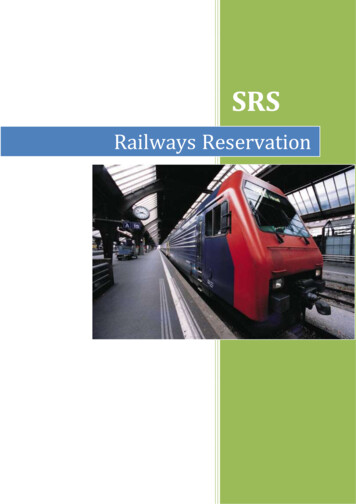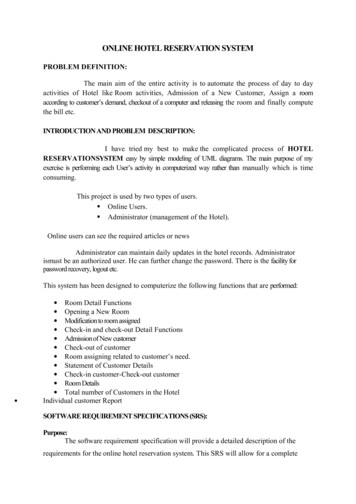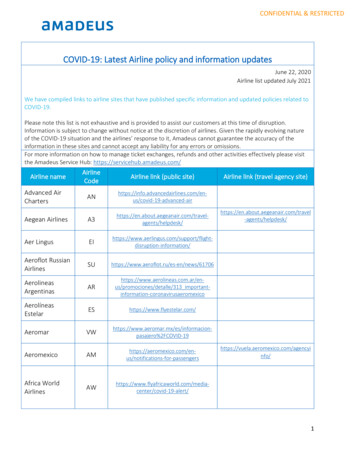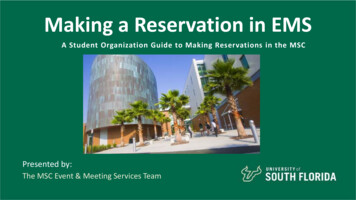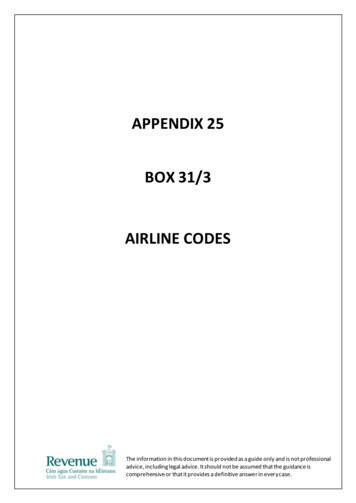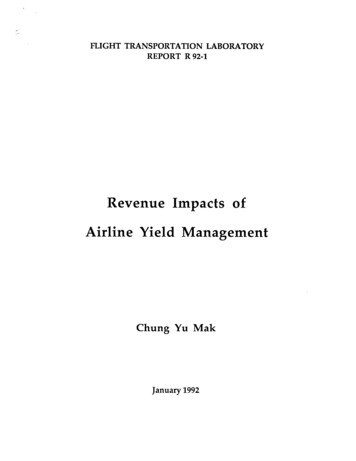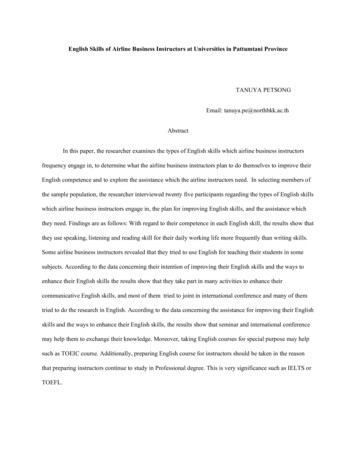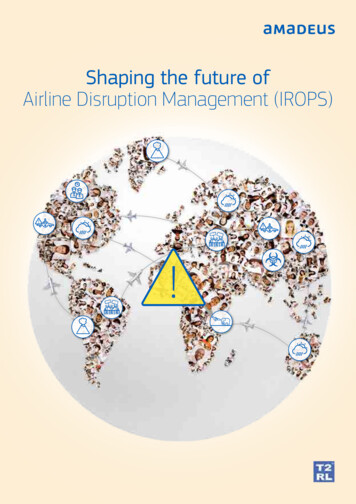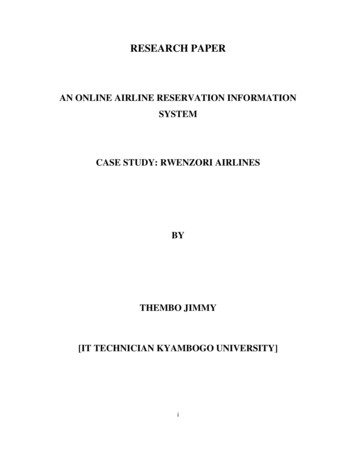
Transcription
RESEARCH PAPERAN ONLINE AIRLINE RESERVATION INFORMATIONSYSTEMCASE STUDY: RWENZORI AIRLINESBYTHEMBO JIMMY[IT TECHNICIAN KYAMBOGO UNIVERSITY]i
TABLE OF CONTENTSLIST OF TABLES . ivLIST OF FIGURES . viLIST OF ABBREVIATIONS. viiiABSTRACT . ixCHAPTER ONE .11.0 Introduction .11.1 Background of the Study.11.2 Problem statement .21.3 Objectives .21.3.1 General Objective .21.3.2 Specific Objectives .21.4 Scope of the Study .31.5 Significance of the Study .3CHAPTER TWO .4LITERATURE REVIEW .42.0.Introduction .42.1 History of Airline Reservation Information System .42.2Reservation Information Systems .52.3 Components of Reservation Information Systems .62.3.1 Hardware.72.3.2 Software .72.3.3 Data .72.3.4 People .72.3.5 Procedures.82.3.6 Database .82.4 Types of Reservations in Reservation System .82.5 Types of Information System .92.5.1 Transaction Processing System (TPS).9ii
2.5.3 Management Information System (MIS) .92.5.4 Decision-support systems (DSS). 102.5.5 Executive Support System (ESS) . 102.6 Application of Reservation Systems . 102.7 Advantages of Reservation Information Systems . 102.8 Limitations of Reservation Information System . 11CHAPTER THREE . 12METHODOLOGY. 123.0 Introduction . 123.1 System Study and Analysis . 123.1.1 Interviews. 123.2.2 Questionnaire . 133.3 Requirements Determination . 143.3.1 Requirements Analysis . 143.4 System Design . 143.5 System Implementation. 153.6 System Testing . 153.7 System Validation . 16CHAPTER FOUR . 17SYSTEM DESIGN, ANALYSIS AND IMPLEMENTATION. 174.0 Introduction . 174.1 System Design Objectives. 174.2 System Design . 184.2.1 Logical design . 184.2.2 Conceptual design . 184.2.3 Physical design . 184.3 Functional Requirements . 194.4 Non-functional requirements . 194.5 Data Flow Diagrams . 204.5.1 Context Diagram for Airline Reservation System . 22iii
4.5.3 Level One Data Flow Diagram for Reservation Process. 234.6 System Component Interactions. 234.7 Database design . 244.7.1 Entities . 244.7.3 An Entity Relationship Diagram for Airline Reservation . 254.7.4 Database Conceptual Design . 264.7.5 Table Attribute Description (Physical Design) . 264.8 System Implementation. 294.8.1 System Users . 304.8.2 Implementation Requirements . 314.8.3 System Execution Sequence . 31CHAPTER FIVE. 44FINDINGS, CONCLUSION AND RECOMMENDATIONS . 445.0 Introduction . 445.1 Findings . 445.2 Conclusion . 455.3 Conversion . 465.4 Recommendations. 46References . 47APPENDICES . 49Appendix A: Interview Guide Questions . 49Appendix B: Questionnaire . 50LIST OF TABLESiv
Table 1: Showing Passenger‟s details . 27Table 2: Showing Flight details . 27Table 3: Showing Payment details . 28Table 4: Showing Journey details . 28Table 5: Showing Schedule details . 29v
LIST OF FIGURESFigure 2.1: Showing a global distribution system .6Figure 2.2: Five Stages of Transaction Processing System.9Figure 3.1: The system study and design model. 12Figure 4.1: Showing a context diagram for a reservation system . 22Figure 4.2: Level one data flow diagram for the reservation process . .23Figure 4.3: Showing interconnectivity of the different system components . 24Figure 4.4: Showing an entity relationship diagram for airline reservation system . 25Figure 4.5: Showing the data base logical design for an airline reservation system . 26Figure 4.6: Administrator use case diagram . 30Figure 4.7: Customer use case diagram . 30Figure 4.8: Showing a Guest User case diagram . 31Figure 4.9: Showing the Welcome Interface . 32Figure 4.10: Showing Customer Registration Form . 32Figure 4.11: Showing the Customer Search Interface . 33Figure 4.12: Showing a Full Customer Record Interface. 34Figure 4.13: Showing Journey details Interface . 35Figure 4.14: Showing Rwenzori Airlines Schedules . 35Figure 4.15: Showing flight Reservations, Ticket Reservation and Cancel Interface . 36Figure 4.16: Showing a Flight Booking Form. 36Figure 4.17: Showing Ticket Booking Form . 37Figure 4.18: Showing Ticket detail interface . 38Figure 4.19: Showing ticket Cancelation Interface. 38Figure 4.20: Showing Customer Contact us Page/Interface. 39vi
Figure 4.21: Showing Administrators‟ Password Interface . 40Figure 4.22: Showing Administrators Home Interface . 40Figure 4.23: Showing change password change interface . 41Figure 4.24: Showing database interface . 41Figure 4.25: Showing flight schedule interface . 42Figure 4.26: Showing journey entry form . 42Figure 4.27: Showing add ticket interface. 43Figure 4.28: Showing flight information interface . 43vii
LIST OF ABBREVIATIONSARS:Air Reservation SystemCASE:Computer-Aided Software EngineeringCRS:Computer Reservation SystemDB :Data BaseDBMS :Database Management SystemDDL :Data Definition LanguageDFD :Data Flow DiagramDML:Data Manipulation LanguageDSS:Decision Support SystemsEG:Example GivenERD:Entity Relationship DiagramFK:Foreign KeyGB:Giga ByteGDS:Global Distribution SystemGUI:Graphical User InterfaceHTML:Hypertext Markup LanguageMB:Mega ByteMHz:Mega HertzMIS:Management Information SystemsPHP:Hypertext PreprocessorPK:Primary KeyPSS:Passenger Service SystemRAM:Random Access MemoryTCP/IP:Transmission Control Protocol/ Internet ProtocolTPS:Transaction Processing Systemsviii
ABSTRACTAirline Reservation Systems (ARS) used to be standalone systems. Each airline had its ownsystem, disconnected from other airlines or ticket agents, and usable only by a designatednumber of airline employees. Travel agents in the 1970s pushed for access to the airlines'systems. Today, air travel information is linked, stored, and retrieved by a network of ComputerReservations Systems (CRS), accessible by multiple airlines and travel agents.This report is a summary of the study that was undertaken to design and implement an airlinereservation system. The airline reservation system designed in this project was developed usingphp, java script and html as the programming languages and Mysql as the database Managementsystem. The researcher reviewed the literature of reservation systems in chapter two andexplored the advantages and limitations of reservation system in real life situations.The researcher used interviews and questionnaire methods during the data collection phase, thesedata collection methods helped the researcher to better understand the existing system in use.Case tools and data flow diagram were used during the development process to simulate theprocess of airline reservation and ticket booking. The outcome of the study was an online airlinereservation system tested and implemented in the case study Rwenzori Airlines to book, scheduleand reserve flights.ix
DEFINITION OF KEY TERMSAirline Industry (Air Transport Industry): This is an area of commerce that uses aircraft totransport people, cargo, and mail. The air transport industry encompasses flights of commoncarriers (government-certified companies that offer cargo and passenger services to the public)and general aviation (private aircraft used for recreation or businessReservation: The written record or promise of an arrangement by which accommodations aresecured in advance.System: This is any collection of component elements that work together to perform a task. Incomputer science, System is used in a variety of contexts. A computer System is a hardwaresystem consisting of a microprocessor and allied chips and circuitry, plus an input device(keyboard, mouse, disk drive), an output device (monitor, disk drive), and any peripheral devices(printer, modem).Deregulation: The act of freeing from regulation (especially from governmental regulations).Network: In computer science, a network is a system used to link two or more computers.Network users are able to share files, printers, and other resources; send electronic messages; andrun programs on other computersComputerize: To control a function, process, or creation by a computer.x
CHAPTER ONE1.0 IntroductionIn science and technology, the desire for improvement is a constant subject which triggersadvancements. This is visible in every ramification and the airline industry is not an exemption.Airline reservation systems were first introduced in the late 1950s as relatively simple standalonesystems to control flight inventory, maintain flight schedules, seat assignments and aircraftloading. Today modern airline reservation systems are comprehensive suites of products toprovide systems that assist with a variety of airline management tasks and service customerneeds from the time of initial reservation through completion of the flight. Winston, (1995) [25]The World Wide Web has become tremendously popular over the last four years, and currentlymost of the airlines have made provision for online reservation of their flights. The Internet hasbecome a major resource for people looking for making reservations online without the hassle ofmeeting travel agents by implementing an online reservation system this ensures that reservationare not only generated by the airline own staff but also by any travel agent using a GlobalDistribution system or other airlines that have a multilateral Interline Traffic Agreement with theairline Winston, (1995) [25].A Computer Reservations System is a computerized system used to store and retrieveinformation and conduct transactions related to travel. Computer reservation systems areclassified as Passenger Service Systems (PSS) which handles a series of critical functions for theairline. For an Airline, the reservation system is a mission critical system that should use thelatest state of the art technology to provide for all flight reservations on a robust platform, whichis flexible and can be adapted to any style of airline. Secure and stable systems are vital to theairline industry which is why companies spend many years designing an architecture specificallysuited to the nature of the airline industry which often requires tens of thousands of users toaccess and use the system simultaneously Wikipedia, May, (2012) [24].1.1 Background of the StudyRwenzori Airlines started as a small airline carrier in 1989 to facilitate air travel between Ugandaand the Democratic Republic of Congo. This airline was to facilitate transportation of cargo1
between the two countries. The airline was originally designed to handle small number ofcustomers. In 1999 Rwenzori Airline was transformed into an International Airline facilitatingtravel of tens of thousands of passengers on a daily basis. Today Rwenzori Airlines still use amanual system of flight booking, flight management and scheduling. Flight booking is donethrough travel agents across major towns, flight data and customer details are kept in manualfiles. This system is slow and results into booking conflicts, vacant seats in some planes and it ishard to quickly obtain customer information in case of emergency. It‟s for this reason, theresearcher set out to design an online airline reservation system to provides a modern, flexiblereservation and inventory management solutions including call Centre, travel agency, internetengine, global distribution systems and interlines booking with case study of Rwenzori Airlines1.2 Problem statementThe current system is manual, this system is slow, time consuming and it is very difficult foreach person to book through office agents. Users inquire about the tickets through phones and itis very difficult for the user to remember all the details that they received through phones. It isvery difficult to calculate how many peoples registered and how many seats on a particular planeare vacant .This requires quite a lot of time and wastage of money as it requires quite lot ofmanpower to do.1.3 Objectives1.3.1 General ObjectiveTo automate the process of airline ticket reservation, booking and airline management henceminimize errors resulting from manual system operations1.3.2 Specific Objectives To study the current system identifying its inefficiencies To determine the requirements for the new system To design an online airline reservation information system to facilitate online bookingand flight scheduling To implement the developed web based airline information system To test and validate the developed system by use of case study2
1.4 Scope of the StudyThe developed system will facilitate online booking; keep customer records, provides an onlinemenu on flight schedules, flight destinations and their prices, show alternative links to otherpartner airlines and will have page dedicated to customer queries and replies. The systemexcludes catering for calculating staff salary and other management issues.1.5 Significance of the StudyFrom the viewpoint of the airline; the system will provide among other things the following;Minimize repetitive work done by the system administrator and reservation clerks. Maintainconsistency among different access modes, e.g. by phone, by web, at the information desk andacross different physical locations. Maintain customer information in case of emergency, e.g.flight cancellation due to inclement weather. Minimize the number of vacant seats on a flight andmaximize flight capacity utilizationReduce effort and frustration for travelers in scheduling a trip, especially by reducing the searcheffort for the flight they need to take. In addition, the outcome of this study will provide a basisfor developing the appropriate approach to the problems associated with air traveling operationsin relation to Airline Reservation Systems3
CHAPTER TWOLITERATURE REVIEW2. 0. IntroductionIn the arena of global competition, organizations all over the world are competing through theuse of the most comprehensive and advanced technological features. The most common exampleof innovation is in the area of information technology and communication. Various industries areusing technology and the advancements of software and internet to maintain and monitor theirbusiness transactions. In the application of the informative systems, the airline industry is themost commonly used system. This chapter explores the concept of reservation informationsystem, their history, components, types and their applications in real world situation to solveproblems2.1 History of Airline Reservation Information SystemAmerican Airlines was the first to establish an automated booking system in 1946. Using asystem to track information and improve efficiency was a highly appealing aim in the industry,and drew the attention of other airlines worldwide. The system endured years of developmentand alterations. Later, other airlines invested more in research and development to launchimproved systems, and through the late 1960s and early 1970s, airlines established their ownsystems.United Airlines developed the Apollo Reservation System, and shortly after allowed travelagents access. The Apollo system was the foundation for many further developments, whichspread from just US airlines to European airlines as well. The research and development ofAirline Reservation System became a significant aspect of the industry and all its air carriercompanies, and partnerships between airlines and technology gurus emerged. Winston (1995)[25]Other airlines soon established their own systems. Delta Air Lines launched the Delta AutomatedTravel Account System (DATAS) in 1968. United Airlines and Trans World Airlines followed in1971 with the Apollo Reservation System and Programmed Airline Reservation System (PARS),4
respectively. Soon, travel agents began pushing for a system that could automate their side of theprocess by accessing the various Airline Reservation Systems directly to make reservations.Fearful this would place too much power in the hands of agents; American Airlines executiveRobert Crandall proposed creating an industry-wide Computer Reservation System to be acentral clearing house for United States travels; other airlines demurred, citing fear of antitrustprosecution. Wikipedia, May, (2012) [24].Airline deregulation occurred in 1978, magnifying the importance of computerized airlinereservation systems and their accessibility. During the early 1970s, as travel agents pushed foraccess to reservation systems, and certain airline executives made investments for the sake ofaccessing the systems of other airlines, antitrust laws came into focus. The purpose of the 1978Airline Deregulation Act in the United States was to eliminate government control overcommercial aviation, and ensure competitive behavior and fair business practices in the airlineindustry. Passengers could gain knowledge of market forces and new market entry in theindustry. Information on specific airlines and the industry as a whole became more widely andreadily accessible, evolving the airline reservation systems from "standalone" operations towardGDS. Today, airline reservation systems have developed into computerized reservation systemswhich are of mission critical to the airline industry, about six major airline reservations systemsare used by international airlines. Winston, (1995) [25]2.2Reservation Information SystemsThe airline reservations system was one of the earliest changes to improve efficiency in theairline industry. Airline Reservation System eventually evolved into the computer reservationssystem (CRS). Airline Reservations System (ARS) is a computerized system used to store andretrieve information and conduct transactions related to air travel. The systems was originallydesigned and operated by airlines, but were later extended for the use of travel agencies.Wikipedia, May, (2012) [24].Major airline reservation system operations that book and sell tickets for multiple airlines areknown as Global Distribution Systems (GDS). Airlines have divested most of their directholdings to dedicated GDS companies, who make their systems accessible to consumers through5
Internet gateways. Modern Global Distribution Systems typically allow users to book hotelrooms and rental cars as well as airline tickets. Wardell, David (1991) [23].Global Distribution Systems(GDS) is a worldwide computerized reservation network used as asingle point of access for reserving airline seats, hotel rooms, rental cars, and other travel relateditems by travel agents, online reservation sites, and large corporations. The premier globaldistribution systems are Amadeus, Galileo, Sabre, and Worldspan. They are owned and operatedas joint ventures by major airlines, car rental companies, and hotel groups. Global, May, (2012)[9].Customer bookingAirline websiteIDS internetdistribution systemGDSTravel agent(using GDS)Central reservationsystemAirline runningFigure 2.1 showing a global distribution system; adapted from ReservationInterfaces, May,(2012) [20]2.3 Components of Reservation Information SystemsThese are complete Information Technology subsystems that make the reservation InformationSystem operational; they are compatible in nature and the failure of one component may affectthe operation of the others with in the system. They consist of computer resources, data, people,and procedures used in the modern business enterprise.6
2.3.1 HardwareO‟Brien (2001) [12] defines hardware as individual physical devices and material used ininformation processing. Specifically, it includes not only machines like computers but also datamedia i.e. all tangible objects on which data are recorded from sheets of paper to magnetic disks.Others include keyboards, mouse, printers, scanners etc.2.3.2 SoftwareRochester et al., (1996) [21] assert that software includes all sets of information processinginstructions and it comprises of different types of programs that enable the hardware to carryoutdifferent tasks. Software is further categorized into system software and Applications software.System software is concerned with keeping the computer system working while Applicationsoftware is the general purpose or written for a specific task li
classified as Passenger Service Systems (PSS) which handles a series of critical functions for the airline. For an Airline, the reservation system is a mission critical system that should use the latest state of the art technology to provide for all flight reservations on a robust platform, which
